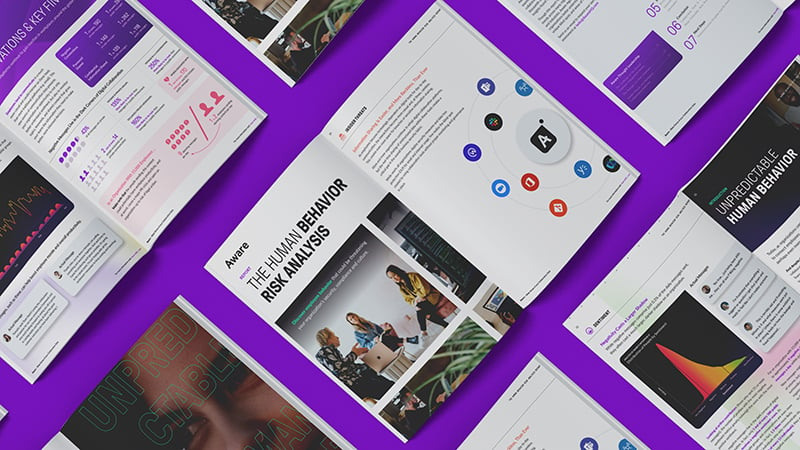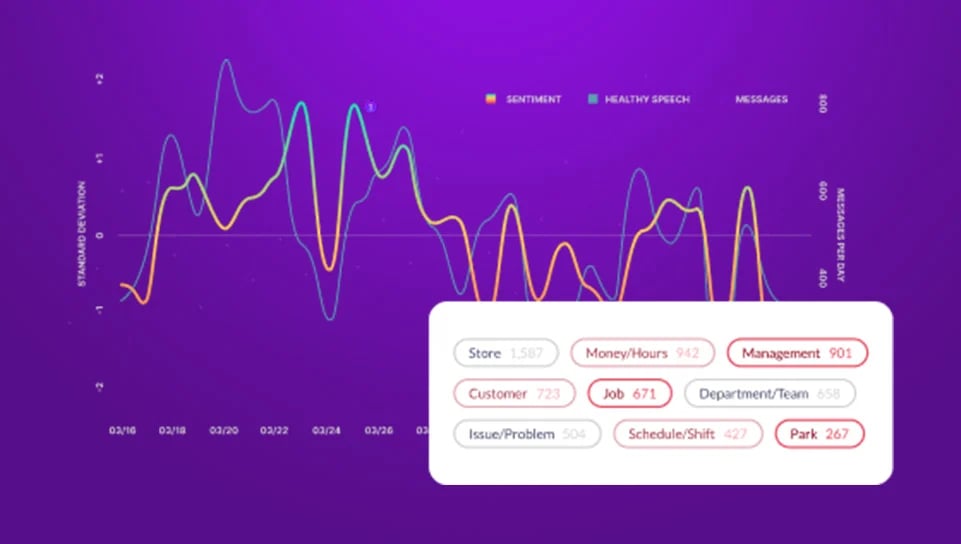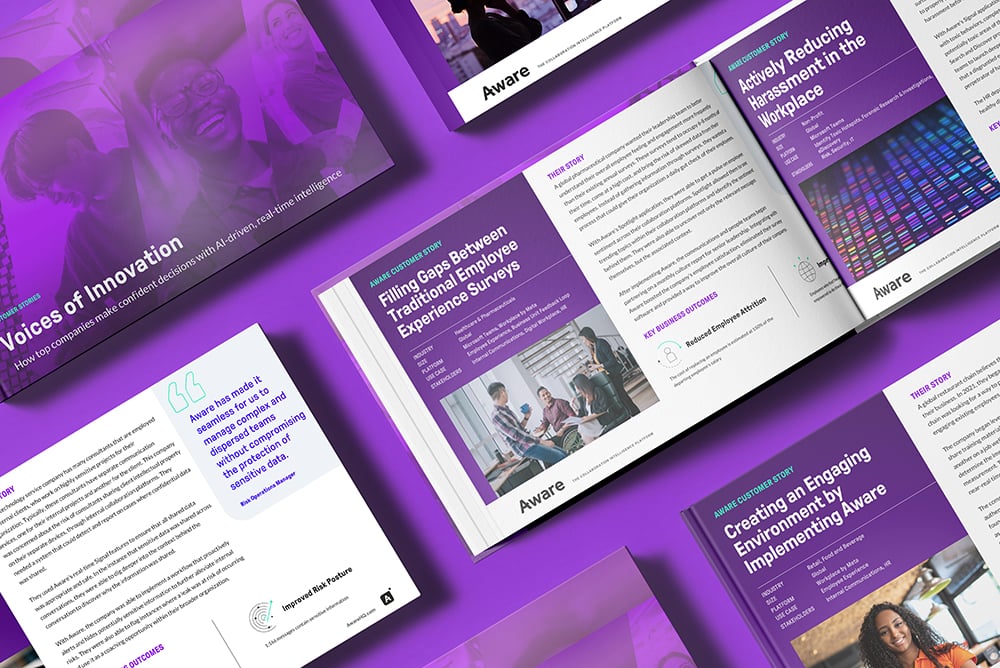PURPOSE-BUILT FOR collaboration tools
Defend sensitive data from loss and exfiltration
Get full coverage and governance for the lifecycle of your data from a platform that provides enterprise-wide protection and visibility.
Easy to Use
Aware's intuitive dashboard unifies and simplifies rule creation across your collaboration stack.
Get Results Faster
AI-powered federated search delivers complete, contextual results and enables filtering by multiple parameters to reduce time to solution.
Reduce False Positives
Industry-leading NLP technology understands the context behind messages for more accurate results with fewer false positives.
“The visibility Aware provides is crucial for my business. I had an idea what was coming through before, but now I have even greater clarity.”
— VP of Security
.png?width=480&height=516&name=Image%20(2).png)
POWERING PRODUCTIVITY FROM STARTUP TO FORTUNE 100
KNOW WHAT'S IN YOUR DATA
Understand the scale of your threat exposure.
As collaboration data increases, so does risk. 1:17 messages on platforms like Slack, Teams and Zoom include 3 or more pieces of sensitive or harmful data. A 1,000 person organization should expect:
.png?width=360&height=85&name=Group%20164240%20(1).png)
OUTCOMES
Uncover sensitive data and remediate threats in near real time
Continuously monitor for sensitive information sharing using contextual AI that reduces false positives.
Unify your collaboration data
Aware's native integrations and APIs unify, enrich and protect your collaboration applications within a single, secured environment.
Get ahead of your most pressing security risks
Mitigate data loss and insider risks with AI-driven policies that spot suspicious activities in diverse content types, including code, credential sharing, and NSFW images.
Automate information governance
Create customized workflows tailored to your organization’s data risks and tolerances that secure sensitive data around the clock.
Accelerate incident response
Efficiently address unauthorized data sharing with automated notifications, SIEM integration, and reporting for real-time remediation and training.
Ensure complete data protection
Protect your data with native audit logs, role and data-based access control, BYOK, data encryption in transit and at rest, and more.
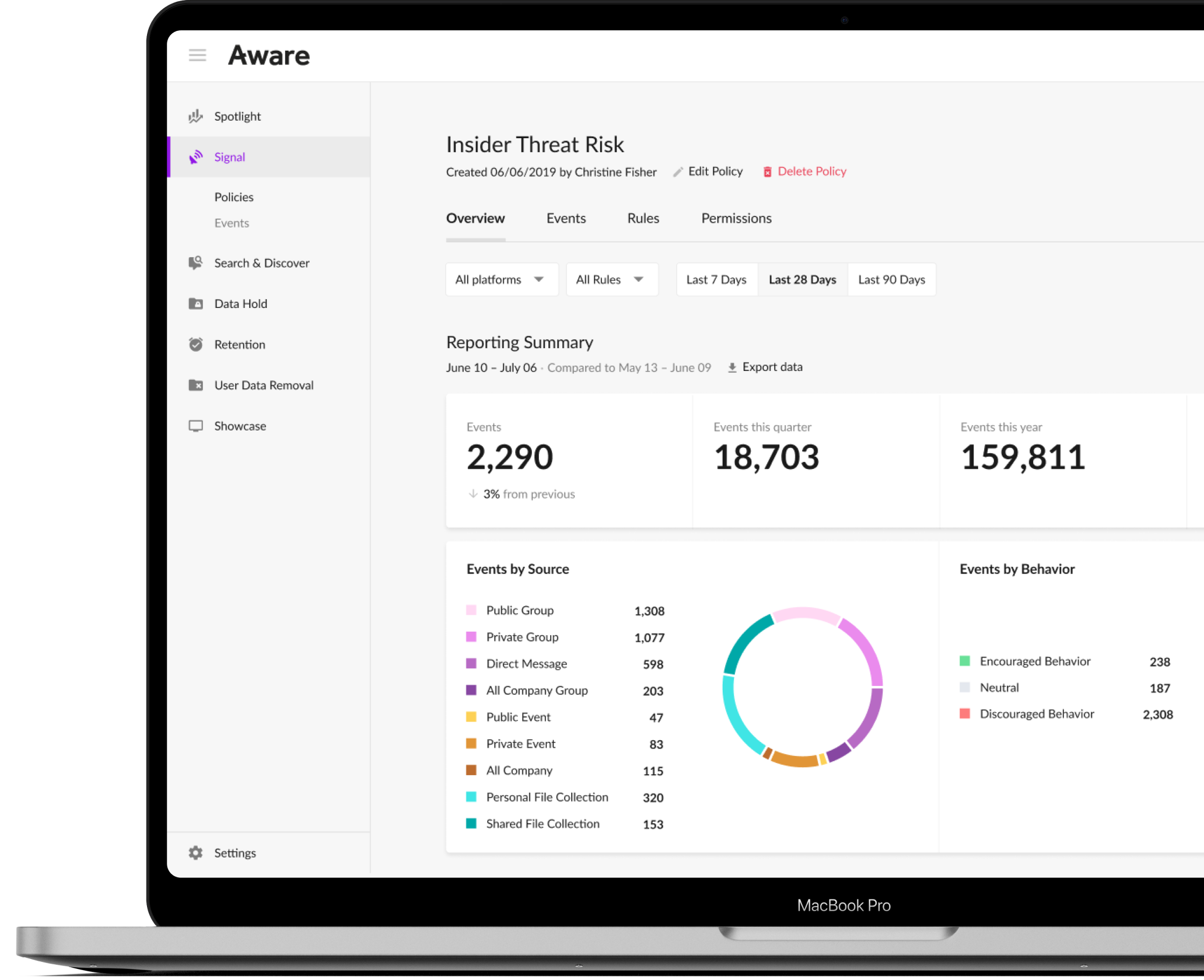

.png?width=2000&name=Mockup%20wrap%20(4).png)
.png?width=688&height=560&name=Macbook%20Pro%2016%20mockup%20(2).png)
.png?width=2000&name=Mockup%20wrap%20(5).png)
AI ANALYSIS
Surface risks with powerful NLP models
Leverage responsibly built NLP models trained to accurately identify security risks in collaboration data.
OCR
Flag risks with PII or other sensitive info with high-contrast images
Toxic Speech & Sentiment
Understand emotions behind text, uncovering key employee insights
Link Reputation & Phishing
Categorize the largest URL database at a rate of 5,000 URLs / sec
Language
Determine languages used within employee communications
NSFW Images
Best-in-class deep learning models to moderate image content
Software Screenshot Detection
Detect sensitive data in screenshots and other digital images
See Aware’s AI/ML models in action.
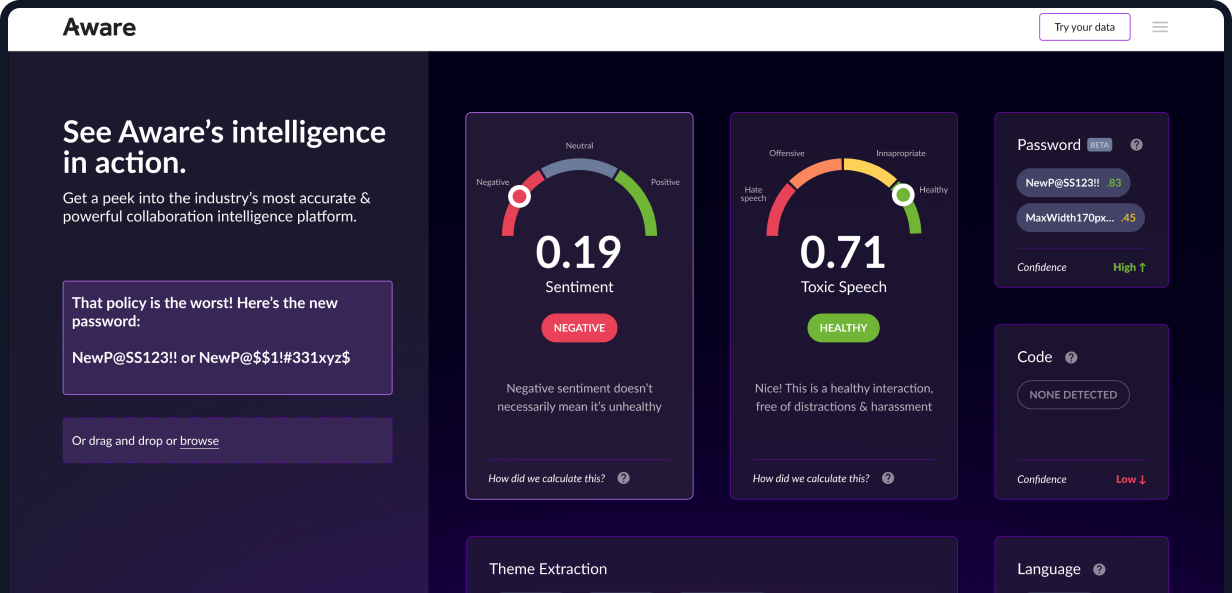
TAILORED TO YOUR NEEDS
Focus on the data you care most about
Effortless configuration and automatic rule setup means more alerts for what you want and less for what you don't.
Targeted data sources
Select the platforms, channels, audiences and people sets most relevant to your search queries and exclude irrelevant data at source.
Configurable classifications
Evaluate files, images, and messages using Boolean logic, OOTB classifiers, ML classifiers, and custom rules.
Automated workflows
Choose the actions to take when rules are triggered, including removing content, notifying stakeholders, and coaching employees.
Integrations
Streamline your workflow
With the click of a button, Aware leverages native APIs and webhooks to ingest and analyze data from across collaboration channels.
Extend the value of the platform by integrating insights from Aware into your SIEM and other key platforms with workflow APIs.
Learn more
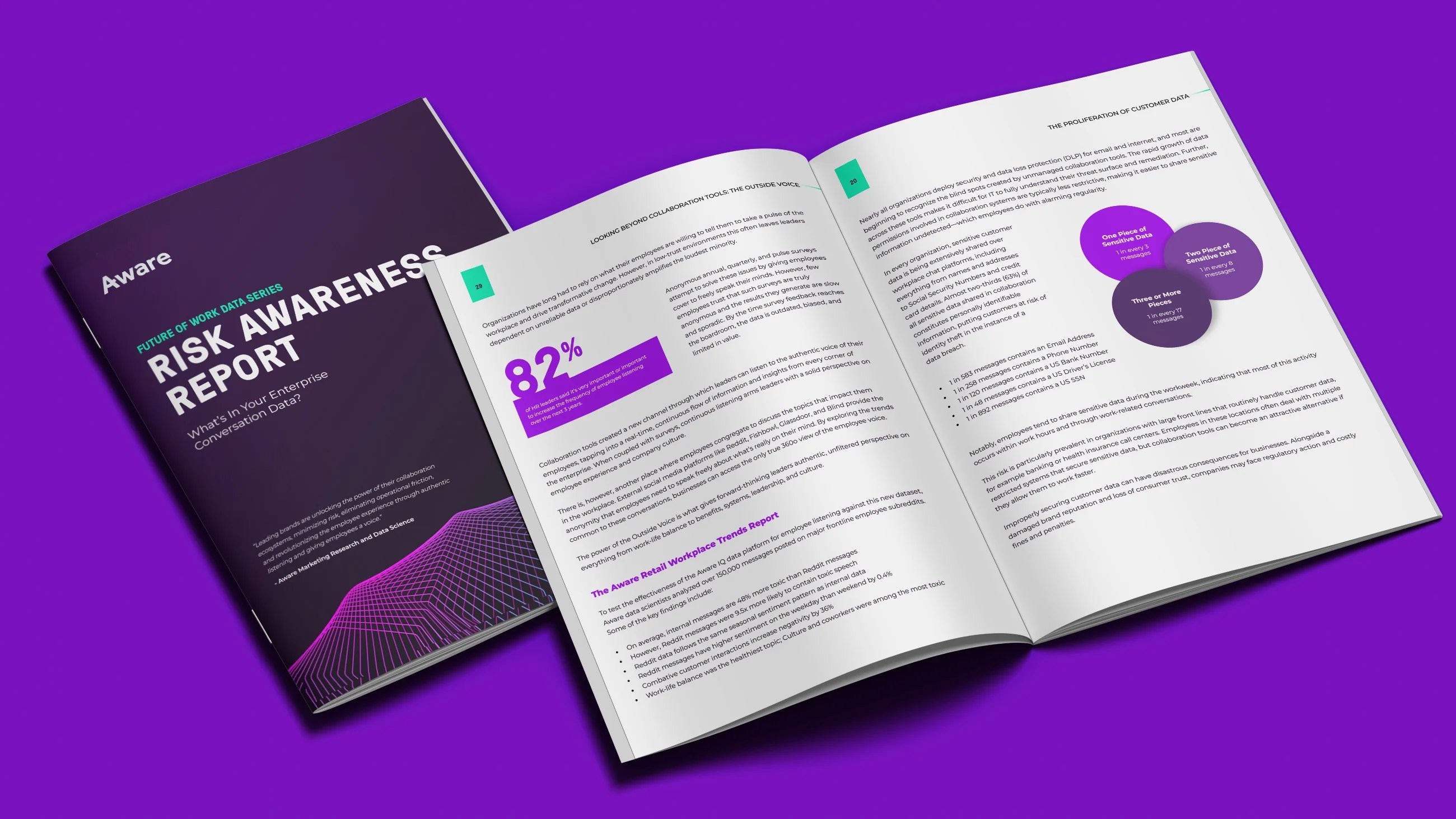
Aware Risk Awareness Report
Learn how much sensitive data really exists in collaboration with stats and facts gained from analyzing 6.6 billion real collaboration messages.

Collaboration Security Checklist
Secure your collaboration tools in minutes with this quick checklist that guides leaders through the controls they need to manage their data.

What's In Your Data?
Claim your free customized report to learn more about the scale of sensitive data proliferation in your collaboration data.

Insider Risk Management
Take charge of malicious and negligent insider threats with real-time contextual analysis normalized for your organization.

Data Loss Prevention
Collaboration tools enable employees to sync data across devices and delete the evidence in seconds. With Aware, you can be faster.

Sensitive Data Discovery
Understand the challenges and benefits of sensitive information monitoring for collaboration data sets.
Questions? We're here to help
Everything you need to know about the Aware platform.
What are collaboration tools? Which tools does Aware support?
Collaboration tools enable teams to work together remotely by providing features such as real-time chat, video calling, screen sharing, and more. Aware supports all leading collaboration tools include Slack, Microsoft Teams, Webex by Cisco, Zoom Team Chat, Google Drive, and Workplace from Meta. See our Integrations page for a comprehensive list. Thanks to Aware’s Context API, enterprises can also connect their own workplace collaboration solutions with Aware’s intelligent data fabric, providing insights and analysis to almost any collaboration dataset.
Why is it important to use a DLP tool built for collaboration? What’s unique about this dataset?
By default, all major collaboration tools allow the end user (“custodian”) to retain complete control over the messages they send. That means at any point a user can edit or delete anything they’ve entered into a collaboration tool. Without a data loss prevention (DLP) solution that can capture a complete record of these conversations as they happen, that context can be lost forever. This is especially critical because collaboration tools often sync across multiple devices, including personal devices enabled under BYOD policies, and can instantly transmit large amounts of sensitive data outside the control of the organization. A DLP solution built for collaboration can mitigate this risk by capturing the context of all activities that take place within those tools.
How does Aware detect sensitive information in collaboration tools?
Aware ingests collaboration tool data in near real time and automatically runs messages through Artificial Intelligence and Machine Learning (AI/ML) infused workflows designed to detect sensitive and noncompliant data-sharing. Aware provides customizable workflows for major compliance regulations such as HIPAA and FINRA, and organizations can create their own workflows for their unique confidential and proprietary data.
What kinds of sensitive information can Aware surface in collaboration tool data?
Aware uses regular expressions (regex) and Boolean logic to search for the most commonly shared confidential or sensitive data. Examples include:
Payment card industry (PCI) information such as credit card numbers, CVV codes, and bank account details
Protected health information (PHI) like diagnoses, medications, and medical appointment dates
Personally identifiable information (PII) information including date of birth, SSN, telephone numbers and addresses
Aware also enables security teams to protect proprietary and sensitive information specific to the enterprise with customizable workflows that can search for any term or phrase. This enables information security controls over details such as mergers and acquisitions, intellectual property (IP), and other confidential business data.
How does AI/ML automation improve DLP in collaboration?
Artificial Intelligence and Machine Learning (AI/ML) infused workflows are an essential component of Aware’s collaboration intelligence platform. These workflows automate the complex work of searching for, identifying, and flagging potentially sensitive, confidential, or proprietary data. With legacy data loss protection tools, infosec leaders may have to manually search through millions of messages and still not have a complete picture of all the potential risks living within collaboration tool data. AI/ML-infused workflows that run in real time give businesses proactive oversight of their collaboration data, enabling more advanced DLP strategies.
How does sentiment analysis support data loss protection measures?
Data loss protection encompasses many different strategies for managing how data moves throughout the organization. The goal of DLP is to secure sensitive data and protect it from being accessed or exfiltrated by unauthorized parties. While studies show that many data loss incidents and breaches are the result of employee error, insider threats remain the most costly and dangerous to modern businesses. Sentiment scoring normalized for the enterprise can help information security leaders to proactively identify where the risk of insider threat is highest by surfacing increased levels of toxicity.
What is the most common type of insider threat in collaboration tools?
According to the Verizon Data Breach Investigations Report, negligent insiders are by far the most common insider risk to any organization, responsible for 62% of all data security incidents. Malicious insiders are responsible for just 14% of insider data breaches. The remainder of cases involved stolen credentials.
Despite being more common, negligent insider threats are typically the least damaging to the enterprise. The average cost of remediating insider negligence was just over $300,000 in 2020, compared with over $750,000 when a malicious insider was the cause of a data breach. Malicious insiders can do more damage by deliberately targeting a company’s most valuable data and evading attempts to be identified.
Overall, insider risk of all kinds is responsible for just 20% of data breach incidents. The other 80% involve external threat actors. However, the cost of remediating an insider breach is much higher — the average insider exfiltrates 10 times more information than the average external threat actor.
How does Aware support insider risk detection in collaboration?
Insider risk can be hard to detect in any organization, but disgruntled employees do make themselves known through their actions. Aware built the industry’s leading natural language processing (NLP) and sentiment scoring models, built for the nuances of collaboration datasets and trained on millions of real collaboration messages. As Aware ingests collaboration data, artificial intelligence workflows analyze and score the sentiment of messages and deliver results normalized for each individual organization. That sentiment scoring provides greater insight into how the mood shifts within the organization, where negativity is strongest, and where toxicity starts to take hold. These insights enable organizations to be proactive about addressing areas with a high potential for insider risk.
What kind of internal investigations can Aware support in collaboration data?
Aware supports forensic search and investigations into collaboration data for a wide range of use cases. Some of the top reasons our customers use Aware to search conversation data include:
Compliance violations
Acceptable Use Policy violations
Intellectual property protection
Data loss
HR investigations
What data preservation factors should businesses consider about collaboration tools?
Collaboration tools can complicate information governance because they make it harder to preserve data. In collaboration tools like Slack and Teams, custodians or end users retain full control of the messages they send. That means a user can edit or delete a message, even months after sending, and those changes will sync across the workspace in real time. This presents challenges for administrators implementing records retention policies. One solution is to disable the ability for custodians to edit or delete their messages. However, this functionality is not available in all collaboration tools, and it can create confusion or frustration when employees make simple spelling mistakes. It may also introduce new risks if an employee accidentally shares sensitive content in the wrong location and is unable to redact it. Aware provides a better solution by capturing a complete record of all messages, including revisions and deletions, in real time. From a centralized pane of glass, Aware give information governance leaders insight into what is happening within their collaboration tools, with no loss of context.
What other use cases does Aware support?
Aware was built to help innovative companies mitigate risk and realize the value locked within their collaboration tool data. Aware ingests collaboration messages in real time and infuses them with intelligent analysis that reveals the hidden context of how modern businesses run. From Aware’s contextual archive, businesses can access a range of use cases, including: compliance adherence, eDiscovery, employee experience, toxic hot spot detection, information governance, and more.
